Next week’s market movers
- In Australia, the RBA is expected to keep its policy unchanged. In light of recent encouraging developments in the economy, we see the case for a more upbeat message by policymakers.
- Sweden’s Riksbank is also likely to stand pat. We expect officials to shift to a more optimistic bias, following in the footsteps of the Norges Bank and the ECB.
- In the US, employment data for June and the minutes from the latest FOMC meeting will keep investors busy.
- We also get key economic data from Japan, the UK, the US, and Canada.
On Monday, during the Asian morning, the Bank of Japan will release its Tankan business confidence survey for Q2. The forecast is for all of the survey’s indices to have risen, something supported by the Reuters Tankan Diffusion Index, which rose notably from the previous quarter on average. An increase in all of these prints would signal that both large and small Japanese firms are feeling more optimistic about current conditions as well as their future outlook. We expect Japanese equity markets to benefit from such an upbeat report, as it could be a signal that GDP growth is set to pick up more steam moving forward. Turning to monetary policy, such strong Tankan prints could add fuel to recent speculation that the BoJ may begin to communicate a plan for its eventual exit from QQE. However, as inflationary pressures remain subdued in Japan, we maintain our view that the Bank is unlikely to alter its current QQE framework any time soon.
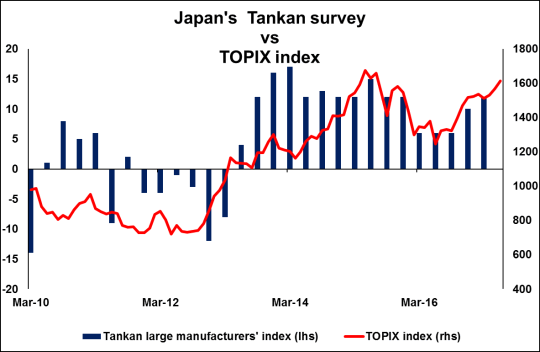
In the US, the ISM manufacturing PMI for June is expected to have ticked up. However, taking a look at the preliminary Markit manufacturing PMI for the month, we believe that the risks surrounding the ISM index are tilted to the downside. The Markit index slid to 52.1 from 52.7 in May, pointing to the slowest improvement in overall business conditions since September 2016.
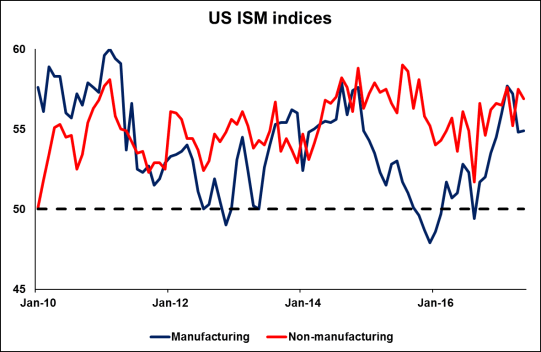
From the UK, we get the manufacturing PMI for June. Then on Tuesday we get the construction index for the same month and subsequently on Wednesday, the service-sector print. The forecast is for all of these indices to have declined. Should these prints show that the UK ended Q2 on a soft footing, and that economic growth may have slowed further, that would likely pour some cold water on market expectations regarding a BoE rate hike at one of the upcoming meetings.
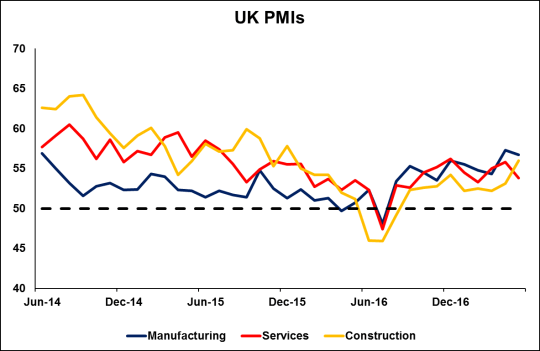
Turning to the political spectrum, Monday marks the end of the 10-day deadline given to Qatar to comply with a list of 13 demands issued by Saudi Arabia, the UAE, Bahrain and Egypt. Qatar is required to shut down the Turkish military base in the country, shut down the Al-Jazeera news network, curb diplomatic ties with Iran, sever all ties to "terrorist organizations", pay reparations for damages caused by Qatari policies in recent years, and more. If Qatar agrees to comply, the four Arab nations will lift the sanctions they imposed earlier in June. However, it is not clear what happens if Qatar fails to meet these demands. In the optimistic scenario, the four Arab nations could simply keep their sanctions in place, which is likely to have little market impact. This is supported by recent comments from the UAE Foreign Minister, who said that "the alternative is not escalation, the alternative is parting of ways". In the unlikely event that the situation does escalate though, investors’ risk appetite may be impacted, with safe haven assets likely to be the main beneficiary. Oil prices could gain in the short-term as well, as the risk of supply disruptions would likely increase.
Markets will stay closed in Canada in Celebration of Canada Day, and will close early in the US ahead of Independence Day.
On Tuesday, during the Asian day, the RBA will announce its rate decision and the forecast is for no change in policy. In recent gatherings, officials maintained a neutral tone overall, but appeared somewhat worried with regards to the labor and housing markets, indicating that developments in these two sectors warrant careful monitoring. The two most recent employment reports from Australia have been stellar, while the house price inflation has begun to cool according to the latest Residential Property Index. As such, we think that policymakers are likely to tone down their concerns at this meeting. Having said that though, we don’t expect any dramatic shift in rhetoric, but rather a slightly more upbeat tone, as the RBA will probably want to examine more than a couple of months’ worth of data before making material changes to its bias.
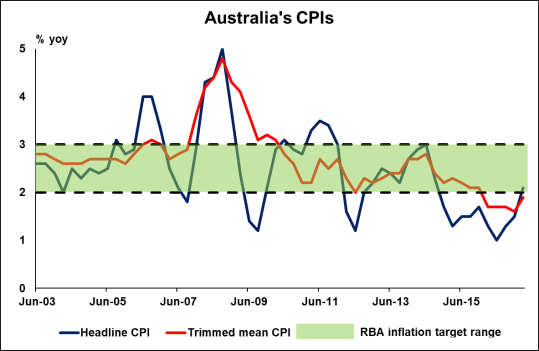
During the European day, the Riksbank will announce its own policy decision. Without a forecast available, we see the case for the world’s oldest central bank to remain on hold. At its latest gathering back in April, the Riksbank extended the duration of its QE program by 6 months to December 2017 and pushed somewhat further out the timing for its first planned rate hike. The tone of the meeting statement was quite cautious, indicating that it will take longer before inflation stabilizes around 2%, and citing considerable uncertainty over political developments abroad. A few weeks after that meeting, the Bank announced plans to move away from its strict 2% inflation target and to introduce a target range of ±1% from 2%. This implies that policymakers may be more tolerant of subdued inflation, which reduces the likelihood for any further easing measures. What’s more, European political risks have dissipated notably following the French election, something that could be reflected in the meeting statement. The combination of these factors makes us believe that the Bank is likely to appear more optimistic this time. In fact, we would not rule out the prospect that the Riksbank follows in the recent footsteps of the Norges Bank and the ECB, by also removing its interest rate easing bias.
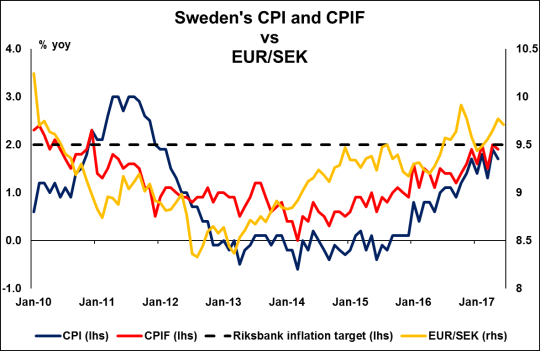
Markets will remain closed in the US for Independence Day.
On Wednesday, the Fed releases the minutes of its June policy gathering, where the Committee raised the Federal funds rate by 25bps. In the statement accompanying the decision, Fed officials noted that they expect to begin normalizing the Bank’s balance sheet later this year in a slow and predictable manner. Meanwhile, they kept the "dot plot" largely unchanged, signaling that one more rate hike is on the cards for this year. In our view, market participants will dig into the minutes for more details on the timing of the balance sheet normalization, as well as any discussion with regards to the timing of the next rate increase. At the time of writing, the market is anticipating the next hike to come in May 2018. This shows that the dot plot has not convinced the financial community, which may need stronger hints before it prices in another hike for 2017.
Our own view is that the Fed will indeed proceed with another hike this year. The Committee has repeatedly pointed out that the softness in the economic data for Q1 is transitory. Indeed, the Atlanta Fed GDPNow model adds credibility to that scenario by indicating that GDP growth rebounded to 2.9% in Q2, while the June employment report is expected to show that the labor market continues to tighten. The key risks to our view are a second quarter of soft GDP and/or further slowdown in the nation’s core inflation.

On Thursday, from the US, we get the ADP employment report for June and the ISM non-manufacturing index for the same month. Getting the ball rolling with the ADP report, the forecast is for the private sector to have added 178k, much less than the 253k print in May. Nevertheless, this would still be a decent print and if met, it may increase speculation that Friday’s NFP will also meet its forecast of 183k. Nonetheless, we have to sound a note of caution. Even though this is the only major gauge of the NFP, the correlation the two numbers has fallen notably during the last few months.
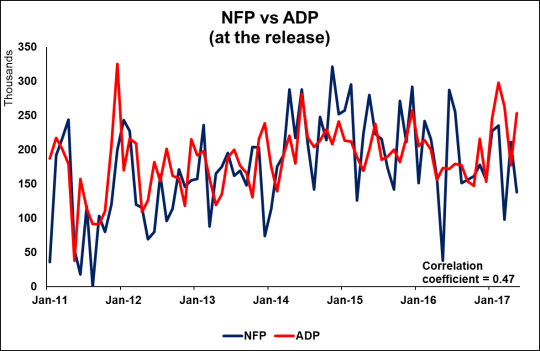
Now, let’s pass the torch to the ISM index. Expectations are for the index to have slid somewhat, but to have remained well above the 50 mark that separates expansion from contraction. The case for a decline in the ISM index is supported by a similar move in the Markit services index for the month, which signaled the slowest upturn in service sector output since March.
On Friday, all eyes will be on the US employment report for June. The forecast is for nonfarm payrolls to have risen by 183k, more than the 138k in May. The unemployment rate is expected to have remained unchanged at 4.3%, while average hourly earnings are expected to have accelerated in monthly terms. Overall, this would be another employment report consistent with further tightening in the labor market, which will be pleasant news for FOMC policymakers. The financial world is currently anticipating the next increase in the Federal funds rate to come in May 2018, while the Fed’s "dot plot" points to such a move coming by the end of this year. Therefore, if the June jobs report is indeed as robust as expected, it could confirm the Fed’s view that the recent softness in economic data is transitory and could bring forth market expectations with regards to the next hike. Having said that though, we believe that the economic indicators that will play the biggest role on the timing of the next move are the nation’s CPIs. Following three months of declining inflation rates, a decent rebound is needed to materially increase the probability for a hike this year.
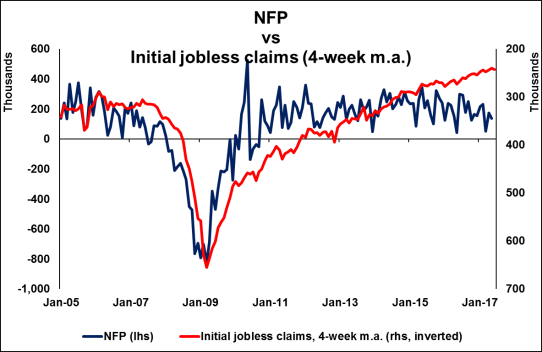
We also get employment data for June from Canada, though no forecast is yet available. Neither the Markit nor the Ivey PMIs for the month have been released yet, implying that we do not have any gauges of how the labor market fared in June. In any case, these data will be closely tracked amid recent signals from BoC policymakers that a tightening move may be on the cards soon. Another month of solid employment gains could add fuel to such speculation. Having said that, even though the BoC may indeed appear more hawkish soon, we doubt that an actual rate hike is looming. We would need to see a significant pickup in the nation’s core CPI rate that has declined for 3 consecutive months now before we join those who are calling for an immediate rate increase.












